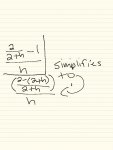I am jumping back into some Calculus, and I've forgotten some basic algebra. I'm sure this is super easy, but I don't remember what the steps to take are, or what this particular problem would be called.
I'm just trying to simplify this expression:

The book says the first part simplifies to the second part, and I simply don't remember how to do this. In addition, if there were a link someone knew about listing these basics rules, it'd be much appreciated.
I'm just trying to simplify this expression:

The book says the first part simplifies to the second part, and I simply don't remember how to do this. In addition, if there were a link someone knew about listing these basics rules, it'd be much appreciated.
